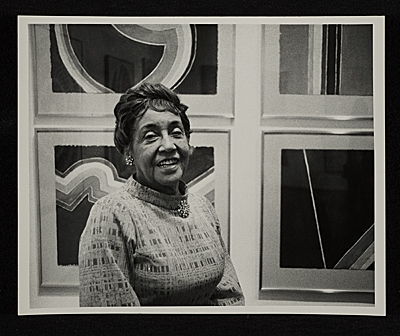
Alma Thomas, Garden Seen from Space, at Aaron Payne Fine Art
About a week before Election Day I encountered, at Aaron Payne Fine Art, a painting titled Circle of Flowers (1969) by Alma Thomas. President Obama and First Lady Michelle Obama selected two Thomas paintings for the White House after President Obama’s first election, borrowed from institutions including the Hirshhorn Museum and Sculpture Garden. Alma Thomas then was singled out for mention in a critic’s notebook by Holland Cotter, in The New York Times, in 2009.

Alma Thomas, Lunar Rendezvous-Circle of Flowers, at Aaron Payne Fine Art
Thomas, per Cotter, was one of only a few women artists whose work the President and First Lady chose. Cotter wrote that Thomas “felt a kinship” with the painters Gene Davis, Morris Louis, and Kenneth Noland — stalwarts of what became known as the Washington Color School — as she “loved color above all in art.” Thomas along with Sam Gilliam were the only two African-American artists of the Washington Color School.
While Thomas only began painting full-time after her retirement from 35 years’ teaching in the Washington, DC public schools (she lived in the same house in Washington, DC for nearly her entire life), in 1921 Thomas was Howard University’s first art major (and one of the school’s first fine art graduates). She made costume designs and drawings (very hard to find, according to Payne) — which tantalize regarding the relationship between her painting (oftentimes in vertical, stripe-like patterns), and her embellished concepts for textiles with their glorious optical repeats. She showed at the first African-American owned gallery in Washington, the Barnett Aden Gallery (which lasted from 1943-69).

Thomas at her opening at the Whitney Museum. Archives of American Art.
Holland Cotter in 2009 offered that Alma Thomas was an exemplary object lesson of the Obama platform: “forward-looking without being radical; post-racial but also race-conscious; in love with new, in touch with old. A genuine rainbow type.”
While I disagree with Cotter’s adjective of “post-racial,” which filmmaker Wendell Harris Jr. interviewed at the Marfa Film Festival called a “canard” in 2009 (and about which this last election cycle revealed lamentable regression), Alma Thomas’s currency in Lunar Rendezvous: Circle of Flowers dealt very much in then current American progress — contemplating how her garden might have looked from space to astronauts on the 1969 moon landing.
Keith Morrison wrote in a catalog accompanying a show, Art in Washington and Its Afro-American Presence: 1940-70 (which has Thomas’s Lunar Rendezvous: Circle of Flowers on the cover) that “this exhibition and essay deal with an era of non-transcendence.” Does he mean in racial relations?
Given all the firsts connected with Alma Thomas, “non-transcendence” seems hard to interpret. She was the first woman art student at Howard, where she studied with James V. Herring (1887-1969), who ran the Barnett Aden Gallery after Aden’s 1961 death. Also close to Herring and a super-sized figure in prominence on campus would have been Professor Alain Locke, a Harvard graduate and the first black Rhodes scholar at Oxford University, who largely posited through cross-disciplinary arts activities the flowerings of the “New Negro Movement.” Locke’s so-called “cultural agenda,” per Steven Watson of The Harlem Renaissance: Hub of African-American Culture, 1920-1930 (New York: 1995, Pantheon Books), dealt in the drama and idiom of theater, of African roots for new art, all of which — in reconsidering the directions from visual arts to theater and back to visual arts — can be argued to have been of influence on Alma Thomas as well. Her color field endured in the garden that she tended at home, and the circles shown in Circle of Flowers were magnetic fields in the largest way.
Thomas had a retrospective show at Howard in 1966 and at the Whitney Museum in 1972 (when she was 80 years old). She was invited to the White House in 1977 by President Jimmy Carter. She died in 1978.
Mindful of that condition of synaesthesia that lets us hear music in the visual, “see” into the aural, and so on, the Archives of American Art tell us that Thomas imagined the wind delivered her colors through the windowpanes, the leaves hummed. She picked up crayons and watercolors to sketch the diurnal garden including and after a lunar eclipse. It’s fabulous to imagine how immense in meaning the lunar landing was to her, and how vividly she offered up our earthly nature and sensorium — as if the men seeing into a D.C. backyard from their craft, in their spacesuits — could use reconnecting to the human parade.
Aaron Payne is at 213 East Marcy Street in Santa Fe. APFineArt.com.
